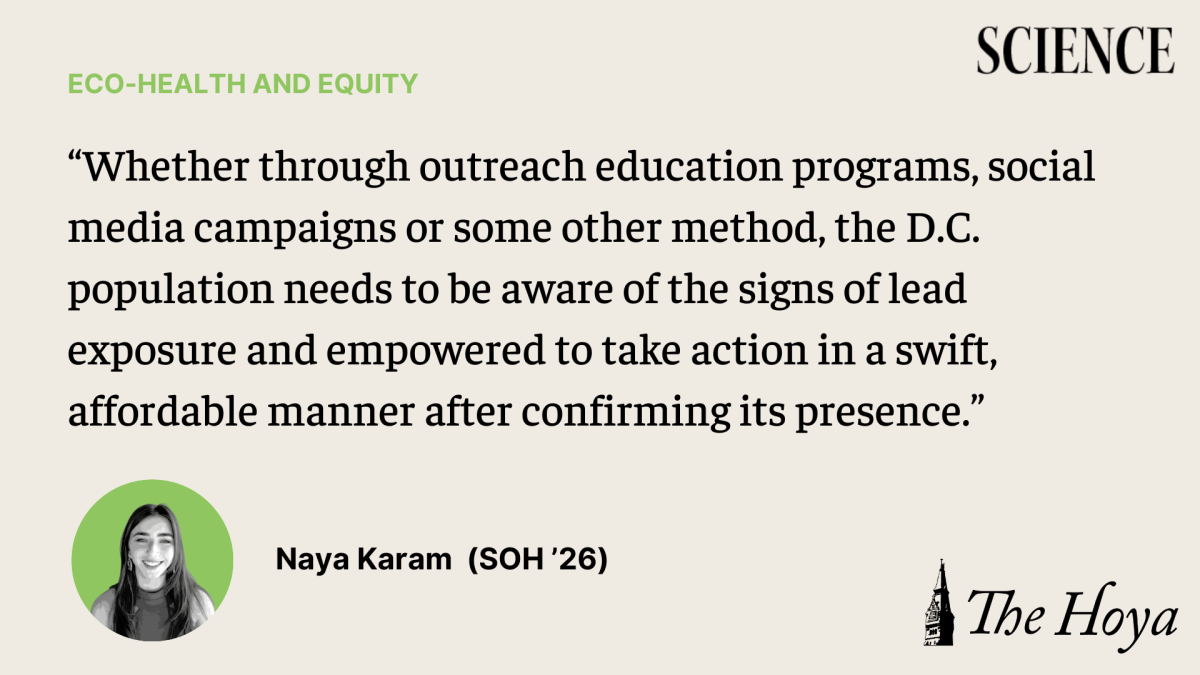Less than 50 years ago, lead was ubiquitous in the United States. Lead paint coated the walls of around 24% of homes, while lead pipes distributed water throughout the country. Though the federal government banned lead paint in 1978, about 31 million homes in the United States still have lead paint on their walls, according to the Environmental Protection Agency. Here in Washington, D.C., a historic city with older housing and pipes, thousands of homes contribute to this statistic, and the District’s water and sewer authority, D.C. Water, estimates that D.C. still uses thousands of lead pipes in water service lines. When lead paint in D.C. homes chips and mixes with dust, or when drinking water passes through these lead pipes, residents risk ingesting this lead and contracting lead poisoning, which can lead to various adverse health outcomes and even death.
In D.C., lead exposure disproportionately impacts lower-income people, particularly in Wards 7 and 8, D.C’s lowest-income districts, with poverty levels that are twice that of the wards west of the Anacostia River. Wards 7 and 8 are also home to a mostly Black population, further underscoring the dangers that D.C.’s at-risk and minority populations may endure.
When they encounter lead contamination, D.C. homeowners, rather than D.C. Water, must do the work to deal with these issues. D.C. Water and the Department of Energy and Environment will deal with public pipes, but expect residents to pay professionals to replace lead pipes and remove lead paint in their homes. While they do subsidize the project in certain cases for particularly low-income homes, many D.C. homeowners do not qualify for full assistance.
Lead exposure in pipes or paints is extremely dangerous. It may cause damage to the central nervous system, which can lead to comas, convulsions and at worst, death. Lead ingestion particularly hurts children, as it can affect their cognitive development and, in severe cases, cause permanent disabilities such as motor function impairment and behavioral disorders. Treatment for these health issues is expensive — putting further financial strain on lower-income people.
The issue of lead exposure also plagues D.C. public schools. In 2016, The Washington Post reported that three D.C. schools in Wards 7 and 8 had unsafe rates of lead in their water pipes, above the safe amount of fifteen parts per billion. D.C.’s Department of Energy and Environment (DOEE) annually samples D.C. water supply to check for lead and responds to complaints of lead in D.C. homes and businesses. D.C. Water currently hopes to have a lead-free D.C. by 2030, but with D.C. residents still suffering from the adverse health consequences of lead poisoning, D.C. Water and the DOEE need to find a more efficient way of managing the lead issue.
If the DOEE and D.C. Water put the responsibility of handling lead exposure on homeowners, then they should better communicate to residents how to recognize and manage potential lead exposure and poisoning. Whether through outreach education programs, social media campaigns or some other method, the D.C. population needs to be aware of the signs of lead exposure and empowered to take action in a swift, affordable manner after confirming its presence. When it comes to a health risk as severe as lead poisoning, resources and information may save lives.









